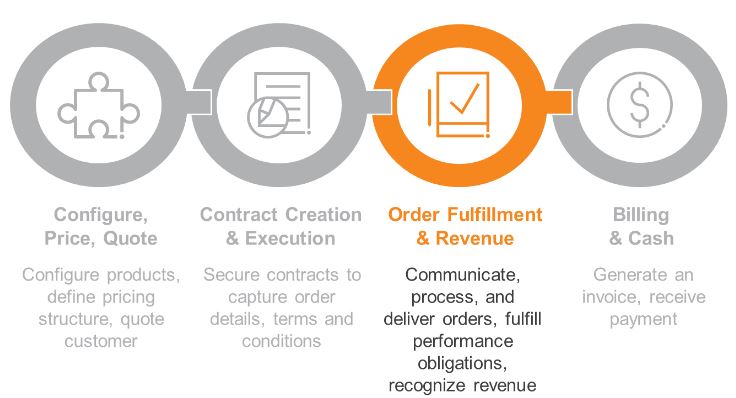Following contract execution (see Create to Execute: Managing the Fine Print of Sales Contracting), the next step in the quote-to-cash process is order fulfillment and revenue recognition. While many people think of this step as picking, packing and shipping, the impact on revenue recognition extends well beyond those three simplified steps. In this step, orders are processed, communicated and delivered, and defined performance obligations are met. The Accounting Standards Update 606 mandates five key steps, outlined in this blog, to ensure organizations and supporting systems are compliant with GAAP principles. Given these guidelines, larger ERP vendors are now entering the fold to support the revenue recognition processes which were more commonly seen in best-of-breed solutions.

Performance obligations vary across industries, service types and companies. It’s important to think about the right questions to ask and the common process and technology challenges within each step. Staying aware of common challenges at each stage, and understanding how it can impact your ERP system, can help prepare organizations to avoid the same pitfalls.
Revenue recognition – the five-step model
Step 1 – identify the contract
The Financial Accounting Standards Board (FASB) provides a five-step process for recognizing revenue from contracts. An enforceable contract must contain approval from all parties, rights and obligations of each party, payment terms, commercial substance and assumption that the customer will pay for the goods or services rendered.
Under ASC 606, multiple contracts with a customer should be combined into one for the purpose of financial reporting if the contracts have the same commercial objective, are interdependent, or share a single performance obligation.
When parties to a contract choose to modify the transaction price and/or scope of the contract, a modification may require a separate contract to avoid prior period revenue adjustments.
Common challenges
-
- Combining multiple contracts into a single revenue agreement where appropriate (relevant for companies moving from other reporting standards to GAAP ASC 606)
- Forming a single revenue contract using data from multiple upstream systems
Step 2 – identify contractual performance obligations
Once all contracts have been identified and/or combined, as applicable, it is required to identify distinct or “bundled” performance obligations within each contract. These performance obligations serve as benchmarks for when and how to recognize revenue.
A good or service is considered distinct when: (1) the customer can benefit from the good or service on its own or with the resource the customer already has access to, and (2) the good or service can be transferred independently of other performance obligations in the contract. Goods or services that are not considered distinct should be combined with other goods or services until the bundle is distinct.
Common challenges
-
- Processing multiple performance obligations that appear as a single line item on a sales order in the form of a bundle
- Determining distinct vs non-distinct performance obligations
- Differentiating which obligations are tied to other obligations when certain promotions are offered, and not a unique obligation that would ultimately be recognized separately. These could include free returns, buy one get one, warranties, free shipping, volume discounts and rebates
Step 3 – determine the transaction price
The transaction price is the amount an entity expects to be entitled to for transferring/providing promised goods or services. The total contract price can be comprised of fixed, variable, or mixed (i.e. a combination of fixed and variable) contract component prices.
Consideration is subject to variability due to timing, performance or other factors that may or may not occur in the future. Examples of variable consideration include discounts, refunds, credits, rebates and other similar items.
Common challenges
-
- Accounting for variable consideration in revenue recognition
Step 4 – allocate the transaction price
Often contracts contain more than one performance obligation, so the total transaction price must be fairly allocated across each performance obligation.
The seller must estimate the stand-alone selling price (SSP) if it is not observable. ASC 606 provides three acceptable methods for estimating SSP: adjusted market assessment, expected cost plus margin approach and residual.
Common challenges
-
- Determining the most accurate SSP estimation method
- Determining the transaction price of unique obligations when multiple SSP estimation methods are used within the same sales order
- Identifying available market data on comparable deliverables to support SSP estimates
Step 5 – recognize revenue
The final step is to accurately recognize revenue as the performance obligations in the contract are satisfied. For performance obligations fulfilled at a point in time, revenue is recognized at the fulfillment of the performance obligation. For performance obligations to be satisfied over time, an entity must decide how to appropriately measure the progress and completion of the performance obligation.
Common challenges
-
- Modifying contracts
- Recognizing event-based revenue
- Incorporating the refund period into revenue recognition timing
Protiviti helps organizations across each step of the revenue recognition process through our solution design methodology and best practices framework. Our approach to solution design and process optimization is built around the principle that system and process improvement is an integrated effort. System changes are driven by proactive optimization and automated solutions rather than an afterthought during the implementation phase. Key steps we assist our clients with in achieving success include:
- Conducting workshops to confirm the company’s executive vision, identify management priorities and outline critical business use cases
- Producing process models including but not limited to revenue recognition
- Evaluating options, selecting and negotiating components, quantifying budget and developing implementation / change management plans
- Leading and assisting with the overall system implementation and transformation effort
Our solution design framework enables successful implementations by helping clients clarify their requirements up front – so teams can focus time, energy and resources on the most impactful areas.
Bob Kiddoo, Senior Director, also contributed to this blog.
Read the results of our new Global IT Executive Survey: The Innovation vs. Technical Debt Tug-of-War.
To learn more about our business application consulting solutions, contact us.







